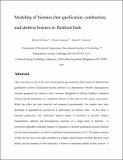| dc.contributor.author | Bates, Richard B | |
| dc.contributor.author | Altantzis, Christos | |
| dc.contributor.author | Ghoniem, Ahmed F | |
| dc.date.accessioned | 2016-12-08T19:32:40Z | |
| dc.date.available | 2016-12-08T19:32:40Z | |
| dc.date.issued | 2016-12-08 | |
| dc.identifier.issn | 0887-0624 | |
| dc.identifier.issn | 1520-5029 | |
| dc.identifier.uri | http://hdl.handle.net/1721.1/105752 | |
| dc.description.abstract | Char conversion is one of the most pivotal factors governing the effectiveness of fluidized bed gasification systems. Gasification-assisted attrition is a phenomenon whereby heterogeneous reactions progressively weaken a char’s structure throughout its lifetime leading to enhanced attrition and the production of a significant fraction of fines that exit the reactor unconverted. While this effect has been observed and measured experimentally, few models have been developed to quantitatively account for it, particularly for biomass chars. In this study, a transient gasification and combustion particle model is presented to describe primary fragmentation, attrition, and heterogeneous reactions of a single batch of particles. A conversion-dependent structural function is proposed to describe gasification-assisted attrition, and the model parameters are fitted to published experimental data from Ammendola, P.; Chirone, R.; Ruoppolo, G.; Scala, F. Proc. Combust. Inst. 2013, 34 (2), 2735–2740. The fragile structure of char derived from wood chips contributes to a higher initial attrition rate than char from wood pellets, but the hardness of both feedstocks is shown to deteriorate rapidly as they convert. A shrinking particle combustion model which accounts for variable feedstock properties is comprehensively presented and validated against the aforementioned data set. The combustion behaviors of both feedstocks are found to strongly depend on particle size/geometry because of significant mass transfer limitations. Using a residence time distribution approach, the model is extended to describe a continuously fed system in order to examine the sensitivity of steady-state outputs (conversion and residence time) to the operating temperature, pressure, and kinetics. As the temperature increases, the char reactivity also increases but the coupled and competing effect of gasification-assisted attrition acts to shorten the residence time of the char particles making complete char conversion very difficult even at 900 °C—the upper operating temperature limit for most single-stage fluidized bed gasification systems. Low operating temperatures result in longer average residence times and higher steady-state char inventories, and slower kinetics lowers the overall conversion. Because of inhibition effects, elevated operating pressures have a smaller impact on improving conversion compared to higher temperature. The steady model further provides a rigorous method for estimating the maximum stable biomass feeding rates as a function of relevant independent parameters including reactor temperature, pressure, volume, and feedstock characteristics. | en_US |
| dc.description.sponsorship | BP (Firm) | en_US |
| dc.description.sponsorship | United States. Department of Energy (National Energy Technology Laboratory Research Participation Program) | en_US |
| dc.language.iso | en_US | |
| dc.publisher | American Chemical Society (ACS) | en_US |
| dc.relation.isversionof | http://dx.doi.org/10.1021/acs.energyfuels.5b02120 | en_US |
| dc.rights | Article is made available in accordance with the publisher's policy and may be subject to US copyright law. Please refer to the publisher's site for terms of use. | en_US |
| dc.source | Prof. Ghoniem via Angie Locknar | en_US |
| dc.title | Modeling of Biomass Char Gasification, Combustion, and Attrition Kinetics in Fluidized Beds | en_US |
| dc.type | Article | en_US |
| dc.identifier.citation | Bates, Richard B., Christos Altantzis, and Ahmed F. Ghoniem. “Modeling of Biomass Char Gasification, Combustion, and Attrition Kinetics in Fluidized Beds.” Energy Fuels 30, no. 1 (January 21, 2016): 360–376. | en_US |
| dc.contributor.department | Massachusetts Institute of Technology. Department of Mechanical Engineering | en_US |
| dc.contributor.mitauthor | Bates, Richard B | |
| dc.contributor.mitauthor | Altantzis, Christos | |
| dc.contributor.mitauthor | Ghoniem, Ahmed F | |
| dc.relation.journal | Energy & Fuels | en_US |
| dc.eprint.version | Author's final manuscript | en_US |
| dc.type.uri | http://purl.org/eprint/type/JournalArticle | en_US |
| eprint.status | http://purl.org/eprint/status/PeerReviewed | en_US |
| dspace.orderedauthors | Bates, Richard B.; Altantzis, Christos; Ghoniem, Ahmed F. | en_US |
| dspace.embargo.terms | N | en_US |
| dc.identifier.orcid | https://orcid.org/0000-0002-8773-4132 | |
| dc.identifier.orcid | https://orcid.org/0000-0002-3959-4489 | |
| dc.identifier.orcid | https://orcid.org/0000-0001-8730-272X | |
| mit.license | PUBLISHER_POLICY | en_US |
